Iran's History
Estakhr Ancient City: Capital of the Sassanian Empire
Estakhr ancient city also known as Takht-e-Tavoos was once one of the most prosperous cities of ancient Persia and was the capital of the Sassanian Empire.
Read moreWhat is Qanat? | Iran’s Ancient Qanat System
A qanat, an ancient underground water channel, skillfully transports water from deep aquifers to the surface, showcasing the ingenuity of traditional Persian engineering in arid landscapes.
Read moreDokhtar Castle in Firuzabad: A UNESCO World Heritage Site in Iran
Fars Province is known as the capital of the 400-year Sassanian Empire, and is home to numerous historical sites from that era. In 2018, some archaeological sites in the region were listed as a UNESCO World Heritage Site under the title "Sassanian Archaeological Landscape of Fars."
Read moreArg-e Alishah in Tabriz: A 700-Year-Old Citadel
Among Tabriz's many attractions, the 700 years old Arg-e Alishah stands out as a monumental piece of the city's past.
Read moreNaqshe Rajab | Iran’s Sassanid Rock Reliefs
Naqshe Rajab is a significant historical site in Iran, showcasing some of the finest rock reliefs from the Sassanid Empire.
Read moreIron Age Museum of Tabriz with Relics from 3500 Years Ago
The Iron Age Museum of Tabriz is renowned as Iran’s first open-air museum. This museum offers a distinctive experience compared to any you've visited before, showcasing ancient skeletons buried using unique methods.
Read moreSarvestan Sasanian Palace | Magnificant Ancient Persian Architecture
The Sarvestan Sasanian Palace is an impressive example of ancient Persian architecture, showcasing the skill and creativity of the Sasanian Empire.
Read moreChehel Dokhtaran Mausoleum: 1,000-Year-Old Mausoleum in Damghan
Chehel Dokhtaran Mausoleum is a remarkable historical site located in Damghan, Semnan Province, Iran. Also known as the "Tomb of Forty Girls," this ancient mausoleum stands as a testament to the architectural and cultural heritage of the 5th century AH (11th century AD).
Read moreHistoric Old Bridge of Dezful – A Sassanid Architectural Marvel
Southern Iran is a region rich in history and culture. Its inhabitants are known for their warm welcome and the area is filled with impressive historical landmarks. Khuzestan province, in particular, has a long history and is home to many ancient sites.
Read moreTarikhaneh Mosque | The 2nd Oldest Mosque in Iran
Damghan, an ancient city, is home to numerous historic sites. Among these is the Tarikhaneh Mosque, a significant example of early Islamic architecture within Iran. Situated southeast of Damghan, this mosque is recognized as one of the country's oldest post-Islamic structures.
Read moreHegmataneh or Ecbatana: Capital of the Median Empire
Ecbatana, literally "the place of gathering," is a city steeped in history and legend. Nestled in the Zagros Mountains on Hegmataneh Hill, it served as the median empire capital and later as the summer capital of the Achaemenid and Parthian empires.
Read moreSheikh Heidar Mausoleum | A Must-See in Meshgin Shahr
Meshgin Shahr, a historic city in Ardabil province, is known for its rich history and numerous attractions, including the Sheikh Heidar Mausoleum and Yeri City.
Read moreArdashir Papakan Palace: Discover Iran's Historic Splendor
Located in Fars province, one of Iran's most historically significant regions, Firozabad, known for its rich history, cultural heritage, and natural beauty, is a key area for nomadic culture in Iran. Firozabad is home to numerous ancient sites that date back to previous eras. Among these, the Ardashir Papakan Palace stands out as a notable attraction.
Read moreKhan Takhty Rock Relief: A Sassanian Masterpiece Near Urmia
Located near the village of Khan Takhti and close to the city of Salmas, the Khan Takhty Rock Relief is carved into the solid face of Kouh Pir Chavoush mountain.
Read moreIran's Beautiful Castles: Top 20 Historical Fortresses You Must Visit
Iran's beautiful castles are among the most cherished tourist destinations in the country.
Read moreKharanaq Historical Village: An Ancient Mud-Brick Town in Yazd
Kharanaq village is a 4,500-year-old abandoned mud-brick town nestled 85 km east of Ardakan in Yazd Province.
Read moreThe Arg of Karim Khan in Shiraz | History and Architecture
Shiraz, a city rich in historical monuments, attracts numerous tourists each year. Among its most significant historical landmarks is Arg of Karim Khan, also known as Karim Khani Citadel, commissioned by Karim Khan Zand, the founder of the Zand dynasty, who was honored with the title Vakil ol-Ra'aya.
Read moreIvan Karkheh | The Largest Buried City of the Sassanid Empire
The sands of time hold buried the grandeur of Ivan Karkheh, an ancient city of the Sasanian period. Once a grand city, it is believed to be even larger than the nearby ancient city of Susa.
Read moreIsfahan's Atiq Square | A Historical Crossroad
Atiq Square, also known as Isfahan Kohneh Square, Sabze Meydan or Imam Ali Square, is a historic landmark in Isfahan, Iran. Located in the city center, it's a popular tourist destination.
Read moreSusa Museum | The One Museum You Don't Want to Miss
Susa is an ancient city dating back over 6000 years that served as a pivotal hub for civilizations such as the Proto-Elamite, Elamite, and Persian empires.
Read moreJameh Mosque of Yazd: A Religious/Historical Must-Visit
Many of Yazd's attractions are historical sites, featuring unparalleled Iranian architecture that each narrates a fascinating story about the city's history. Among the most famous of these historic buildings, located in the city center, is the Jameh Mosque of Yazd.
Read moreWhat is Zoroastrianism Religion? | Ultimate Guide
Zoroastrianism is an old religion that started in Iran thousands of years ago. It's one of the world's oldest religions that people still follow today. This religion teaches about good versus evil, with a focus on choosing good thoughts, words, and actions.
Read moreFire Temple: The Holy Places Where Zoroastrians Worship God
A Zoroastrian fire temple, also known as an agiary (Gujarati: અગિયારી, agiyārī) or in Farsi as an "Atashgah" (آتشگاه), is a place of worship for followers of Zoroastrianism, an ancient religion originating in Persia (modern-day Iran).
Read moreDiscover History at Harireh Ancient City in Kish
All of the ancient world's greatest civilizations boasted a mighty metropolis. These ancient cities rose and fell with powerful empires and left legendary legacies that still endure today.
Read moreDashkasan Temple: A Dragon Temple in Zanjan, Iran
Since the early years of civilization, temples have long served an important role in not only the fabric of countless religions but also the livelihood of communities.
Read moreSepandarmazgan | A Celebration of Love, Women and Earth
Forget about the roses and chocolates of Valentine's Day. In Iran, love is celebrated on Sepandarmazgan, a tradition with a history stretching back over 2,500 years.
Read moreMehregan Festival in Iran | Celebrate Autumn with Zoroastrians
As summer's warmth wanes and the leaves begin to turn, a vibrant festival lights up the autumnal landscape in Iran and Zoroastrian communities worldwide.
Read moreRuins of Apadana Castle in Shush, Iran
The ruins of Apadana Castle in Shush, Iran, stand as a testament to the grandeur of the Achaemenid Empire, a pivotal era in ancient Persian history.
Read moreAmir Chakhmaq Complex | What to See in Yazd, Iran
Imagine yourself wandering through the sun-drenched alleys of Yazd, an ancient Iranian city where adobe houses whisper stories of a bygone era.
Read moreHormuz Portuguese Castle, Iran's Colonial History
Amidst the rich heritage of Hormuz Island, stands the remarkable Hormuz Portuguese Castle.
Read morePigeon Towers in Iran | Legacy of Iranian Dovecotes
Imagine towering cylindrical structures, adorned with intricate brickwork, rising from the ancient landscapes of Iran. These structures are not watchtowers or observatories; instead, they are pigeon towers—a captivating expression of human ingenuity from a bygone era.
Read moreKashan's Top 11 Historical Houses + Photos
Kashan, an Iranian city steeped in history and cultural heritage, is home to a remarkable collection of historical houses.
Read moreMonar Jonban: The Mystery of Iran's Shaking Minarets
If you ever find yourself in the city of Isfahan, Iran, you may come across a remarkable architectural wonder known as the “Monar Jonban, in Farsi منار جنبان” or the Shaking Minarets.
Read moreTop 23 Museums in Iran + Photos
Iran, a nation with a long and rich history dating back to ancient civilizations, possesses a diverse and extensive cultural heritage.
Read moreWhat Is Nowruz? All About the Iranian New Year!
Nowruz, literally translating to "new day" in Persian, signifies the Iranian New Year and the beginning of spring.
Read moreGolestan Palace | A Journey through History
The Golestan Palace, a UNESCO World Heritage Site, reflects Iran's rich history, culture, and art.
Read moreSheikh Safi al-Din Khanegah and Shrine Ensemble
The Sheikh Safi al-Din Khanegah and shrine ensemble in Ardabil, Iran, stands as a remarkable monument, constructed between the early 16th and late 18th centuries.
Read moreMoghadam Museum | Fabulous Art Collections
Amidst the constant updates and modernization in the world, finding a historic house museum in many cities is very rare.
Read moreNational Museum of Iran: Iranian Largest Archeological Museum
If you are looking to witness the history of Iran - from the Stone Age to the 20th century. Visit the National Museum of Iran.
Read moreAnahita Temple | Temple of an Ancient Iranian Goddess
The Temple of Anahita in Kangavar, Iran, stands as a testament to ancient reverence for water, fertility, and wisdom.
Read moreTaq Kasra: World's Largest Single-Span Brick Vault
Throughout history, the significance of many old buildings lies in their construction, achieved without the modern facilities and technologies we have today.
Read moreSiosepol Bridge | 33 Archs on Zayandeh Rud
Isfahan, often referred to as "half of the world" in the Persian proverb "Isfahan Nesf-e Jahan," stands as a city steeped in cultural and historical significance.
Read moreTaq Bostan | Sassanid Rock Reliefs in Kermanshah, Iran
Taq Bostan is a magnificent historical site located in the city of Kermanshah, Iran.
Read moreSassanid Empire: Rise and Fall of the Sasanians
The Sassanid Empire, a formidable Persian dynasty established in the third century CE, represents a pivotal chapter in the annals of ancient history.
Read moreTehran Post & Communications Museum
In the heart of Tehran lies a captivating window into the past - the Tehran Post & Communications Museum.
Read moreOmidvar Brothers Museum: A Gateway to World Cultures
Have you ever wondered what it would be like to embark on a journey that spans continents on a motorbike?
Read moreTehran Time Museum: A Journey Through Time
Are you fascinated by the concept of time and how the invention of clocks has transformed human societies and the way we organize our daily routines? If so, then the Time Museum in Tehran is a must-visit destination for you.
Read moreOmar Khayyam: Scientist, Poet & Philosopher
Omar Khayyam, a name that echoes across centuries, was a true Renaissance man of the East. He traversed the realms of knowledge with boundless curiosity, leaving his mark on the sands of mathematics, astronomy, philosophy, and most famously, poetry.
Read moreCinema Museum of Iran in Ferdows Garden, Tehran
Are you a passionate cinema lover seeking to delve into the rich history of Iranian filmmaking?
Read moreSilk Road in Iran | Iran's Historic Silk Road Heritage
The Silk Road, an ancient network of trade routes, holds profound historical importance.
Read moreGhoortan Citadel | Desert Fortress of Legends
Located in the heart of Isfahan province, Iran, lies the historically significant Ghoortan Citadel, an architectural marvel resonating with tales of the past.
Read moreA Guide to the Towers of Silence in Yazd, Iran
Imagine a world where fire, water, earth, and air are held sacred, and the natural world is seen as a canvas for the divine.
Read moreNader Shah Afshar: The Conqueror of Empires
Nader Shah, known as a formidable military leader and ruler, left an indelible mark on Persian history during the 18th century.
Read moreKhanat Caravanserai | Where History Meets Modernity
Located at the heart of Tehran stands the captivating Khanat Caravanserai, an architectural gem that traces its roots back to the illustrious Qajar era.
Read moreMasoudieh Mansion: A Must-Visit Historical Palace
Have you ever envisioned yourself as royalty, wandering through halls adorned with splendor and grace? Visit the Masoudieh Palace, also known as "Emrat-e Masoudieh, a captivating treasure nestled in the historic center of Tehran.
Read moreKhaf City: Off-the-Beaten-Path Adventure in Iran
Khaf City, nestled in the northeastern region of Iran, boasts a rich historical tapestry that dates back centuries.
Read moreFrieze of Archers: The Ancient Persian Power
In the heart of ancient Persia, etched upon the crumbling walls of Persepolis, a silent parade of warriors’ marches.
Read moreAncient Village of Nashtifan: Whispers of History
Nashtifan, Iran, is a historical village located in the Tabas desert, offering a unique blend of cultural heritage and natural beauty.
Read moreThe Historical Qasr Prison Museum: A Travel Guide
Have you ever delved into Ken Follet's novel "On Wings of Eagles"? If you have, then you're already familiar with the iconic Qasr Prison.
Read moreThe Greatest Persian Poets throughout the History
Persian poetry, a vibrant tapestry of centuries, showcases unique contributions from poets who have shaped cultural and literary landscapes.
Read moreShahnameh: The Epic Persian Book of Kings
The Shahnameh, often referred to as the "Book of Kings," stands as an illustrious epic poem in Persian literature, composed by the revered poet Ferdowsi.
Read moreBisotun: Rock Relief and Inscription of the Achaemenids
Kermanshah boasts ancient stone inscriptions and carvings that have stood the test of time, spanning from the Achaemenid period to the present day in a secluded corner of the city.
Read moreIran Windmill | Ancient Windmills in Iran
Throughout history, humans have harnessed the power of wind for various purposes. From crossing vast oceans to grinding grains and pumping water, the wind has played a crucial role in shaping our lives.
Read moreFiruzabad: The Ancient Capital | The Rise and Fall of Gor City
Firuzabad, also known as Gor City, is an ancient city located in Fars Province, Iran. It is believed to have been built by Ardashir I, the founder of the Sasanian Empire, in the 3rd century CE.
Read moreWhy Did Persia Change Its Name to Iran?
Many people today may be familiar with Persia through popular culture and films, such as "The Prince of Persia." However, they might not know that Iran is the modern name for the historical region once known as Persia.
Read moreThe Simurgh | Iran's Mythical Bird | Persian Myth
Have you ever wondered about the mythical creatures that populate the folklore and literature of different cultures? From dragons and unicorns to mermaids and griffins, these fantastical beings have captivated the imagination of people for centuries.
Read moreWhy Iran is Not an Arab Country - Learn the Difference!
Iran is frequently misconstrued as an Arab country, a misperception we aim to dispel. While it shares some similarities with its Arab neighbors, Iran stands as a distinct entity.
Read moreAlamut Castle | Mythic Mountain Stronghold
High in the mountains of Iran, you'll find Alamut Castle, a fascinating place with ancient stories to tell.
Read moreShah Mosque, Isfahan | A Complete Visitor Guide
Isfahan, often referred to as "Nesf-e Jahan" (Half of the World), is a city with a long history, and the Shah Mosque (Masjid Imam) is right in the middle of it.
Read moreFaravahar as a Universal Symbol of Unity
The Faravahar, “فَرَوَهَر” in Farsi, a captivating symbol with deep roots in Zoroastrianism, stands as an emblem of profound significance within Persian culture.
Read moreKamal-ol-Molk: The Iconic Persian Artist
The significance and popularity of Kamal-ol-Molk are woven into the fabric of Iran's cultural heritage.
Read moreHuma Bird: Exploring the Mystical Legends and Reality
The Huma bird, often regarded as one of the most fascinating mythical creatures, has left an indelible mark on the tapestry of human imagination across numerous cultures and religions.
Read moreAttar of Nishapur: The Sufi Poet and Philosopher
Attar of Nishapur, a luminary in the realm of Persian literature and Sufi philosophy, stands as an enduring figure whose words have transcended centuries, leaving an indelible mark on both poetry and spirituality.
Read moreMystical Essence of Anahita: Goddess, River, and Myth
The name "Anahita" carries a mystique that spans both ancient and modern realms, intertwining the threads of history, mythology, and cultural significance.
Read moreShushtar Hydraulic System: Ancient Engineering Wonder
The Shushtar Historical Hydraulic System stands as a remarkable testament to ancient engineering prowess and ingenuity.
Read moreNaqsh-e Rustam: Ancient Treasures & Zoroastrian Legacy
Located in the city of Marvdasht, Iran, Naqsh-e Rustam stands as an archaeological treasure trove.
Read moreChehel Sotoun Palace: Iran's Timeless Marvel
Isfahan is known for being a city characterized by numerous exquisite gardens, historic bridges, and palaces. The majority of these landmarks boast a history spanning at least a century.
Read moreTirgan Festival; Water Festival in Iran from Ancient Times
The Tirgan Festival, a captivating celebration deeply rooted in Iran's cultural history, stands as a testament to the enduring significance of water in the lives of Iranians.
Read moreChogan (Polo): A Horse-Riding Game Originated in Iran
Chogan or Polo is a horse riding game of Persian heritage that traces back to the 6th century B.C.
Read moreMolla Sadra | Persian Philosopher and Theologian
If you love to think deeply about the big questions in life and consistently seek to expand your understanding of the world, welcome to the world of Molla Sadra...
Read morePasargadae: Legacy of Cyrus the Great & Ancient City
Pasargadae, an ancient city located in present-day Iran, holds immense historical significance as the capital of the Achaemenid Empire and the final resting place of one of history's most renowned leaders, Cyrus the Great.
Read moreVank Cathedral | Persian & Armenian Cultural Masterpiece
Vank Cathedral, an architectural gem nestled in the heart of Isfahan, Iran, stands as a testament to the rich history and cultural diversity of the region.
Read moreAvicenna (Ibn Sina): The Persian Philosopher
Avicenna, also known as Ibn Sina, was a renowned Persian philosopher whose contributions have left an indelible mark on various fields of knowledge.
Read moreTop 10 Historical Sites of Iran
Iran is a land of timeless beauty, where the echoes of past empires still resonate through the ages.
Read moreIran UNESCO World Heritage Sites
According to the UN cultural organization UNESCO, Iran is home to more than 20 World Heritage Sites with a highly rich history.
Read moreTakhte Soleyman (Throne of Solomon), UNESCO World Heritage Site
In the northwestern part of Iran, there is a World Heritage Site called Takhte Soleyman, or the Throne of Solomon.
Read moreSaadi Shirazi: The Major Persian Poet of All Time
One of the best places to visit in Shiraz is the Tomb of Saadi, known as Sa'diyeh. Saadi Shirazi is the major Persian poet of all time, who was born and buried in Shiraz.
Read moreCyrus The Great – The Most Powerful King in The World
Cyrus II, also referred to as Cyrus the Great, was the first ruler of the Achaemenid Empire and the fourth king of Anshan.
Read moreArg-e Bam: The Fascinating Citadel of Ancient Persia
Rising like a Phoenix from the ashes of the devastating 2003 Bam Earthquake, Arg-e Bam, also known as the Bam Citadel, is a magnificent ancient mud city and the largest adobe structure on earth.
Read moreChak Chak Pilgrimage Site | A Cultural Gem in Central Iran
Chak Chak is a pilgrimage site located in the central desert region of Iran, near the city of Ardakan.
Read moreOpert Ridge: A Majestic Natural and Cultural Haven in Semnan, Iran
Are you ready to begin a journey to uncover a hidden gem tucked away in the heart of Semnan, Iran?
Read moreThe History of Azadi Tower in Tehran
Azadi Tower, also known as Freedom Tower, stands tall as a sentinel overlooking Tehran and welcoming visitors worldwide.
Read moreIran's Ziggurats: Unveiling the Secrets of the Past
The term "ziggurat" is derived from the Babylonian word "ziqqurratu," which translates to "mountain peak" or "pinnacle."
Read moreIran Windcatchers – What Is Iran Known For?
Iranian architecture has a long and diverse history, dating back over 3,000 years.
Read moreChoqa Zanbil Ziggurat: An Ancient Wonder of the World
The Choqa Zanbil Ziggurat is an ancient structure located in Khuzestan Province, Iran.
Read moreTop 20 Caravanserais in Iran that will WOW You
A location for caravans (a group of travelers) to stop and refresh after long days of traveling on trade routes, caravanserais are one of Iran's most significant and magnificent historical monuments.
Read morePersian Empire; Facts & History of Achaemenids
The Persian Empire, also known as the Achaemenid Empire, which spanned over two million square miles and housed over half of the world's people, was established around 2,300 years ago.
Read moreSilk Road in Iran: The Ancient Paths
The name "the Silk Road" takes the mind back to the past and evokes memories of a voyage where horse and camel caravans carry valuable commodities, including silk, and spices, across exotic and dangerous lands, desert oases, and wealthy cities.
Read moreSusa Persia; One of the Oldest Cities in the World
One of the world's oldest cities is Susa city, also known as Susa Persia.
Read moreWhat Is the Iranian New Year? All About Nowruz!
One of the richest cultures in the world, Persian culture, has had a significant impact on other cultures as well.
Read moreHistory of Iran
Ancient Iran, also known as Persia, was a region where Persian language and culture prevailed and mostly related to the present-day Fars and part of modern Khuzestan due to the ancient dynasties that arose and flourished in these areas. In general, the history of Iran is divided into two periods: the prehistory and the historical period, which includes the Iron Age, which starts from1500 BC and continues until 550 BC, as well as the formation of the government that begins in the Median period, and it is divided into two phases before (until 642 AD) and after Islam. Here we briefly discuss the historical period of Iran history.
I. Iran's History: Before Islam
1. The Elamites
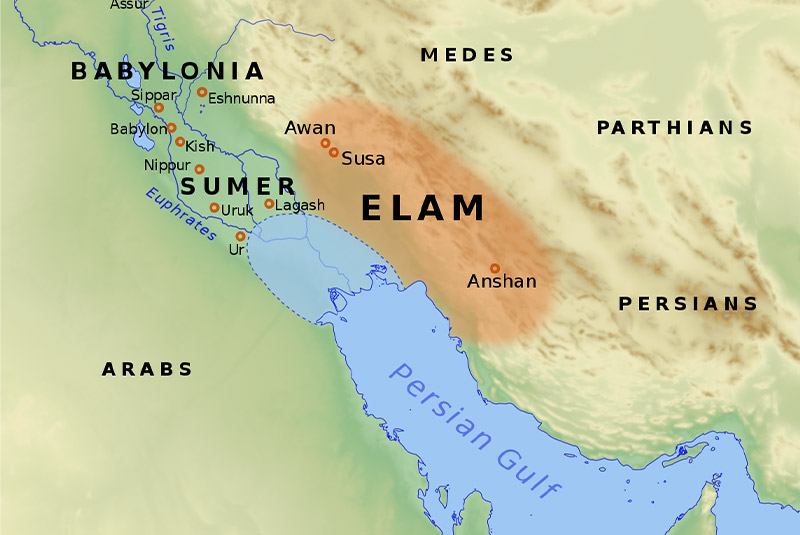
Researchers mainly consider the Zagros mountains as the origin of the Elamites. According to most researchers, the government of Elam was formed from the interaction of the people of the mountains and the inhabitants of the lowlands (Khuzestan). With the beginning of the 3rd millennium BC, the balance of trans-regional trade from East to West along the route of the Great Khorasan, Fars, and Khuzestan roads was disturbed. At the end of this turbulent period, the Elamites established a long-lasting and powerful government by merging the lowland and mountainous regions, which remained stable for two thousand years under the leadership of several dynasties that emerged from the mountainous areas.
The Elamites wrote the names of their kings and generally their proud deeds on clay or stones. These documents show that the Old Elamite period is from about 2400 to 1450 BC[3]. The Middle Elamite period begins around 1450 BC and continues until 1100 BC; at the end of it, complete silence reigns over Elam and most of the lands of the Near East. This silence lasted for about 200 years until the sun of Elamite culture emerged from behind the mysterious corners of history, and thus the Neo-Elamite began. The history of the Neo-Elamite periods starts in 814 BC and ends with the establishment of the Achaemenid government by Cyrus II.
As it is mentioned, Iran’s first organized settlements were established in Elam, the lowland region in what is now Khuzestan province, as far back as the middle of the 3rd millennium BC. Elam was close enough to Mesopotamia and the great Sumerian civilization to feel its influence, and records suggest the two were regular opponents on the battlefield. The Elamites established their capital at Shush.
The Elamites believed in a pantheon of gods. Their most notable remaining building, the enormous ziggurat at Choqa Zanbil, was built around the 13 century BC and dedicated to the foremost of these gods. By the 12th century BC, the Elamites are thought to have controlled most of what is now western Iran, the Tigris Valley, and the coast of the Persian Gulf. They even managed to defeat the Assyrians, carrying the famous stone inscribed with the Code of Hammurabi in triumph.
In the meantime, the Indo-European Aryan tribes arrived from the north and settled near present-day Shiraz. At the same time, the Medes moved to the northwest of today's Iran and established their capital at Ecbatana, now buried under modern Hamadan.
Antiquities of the Elamites:
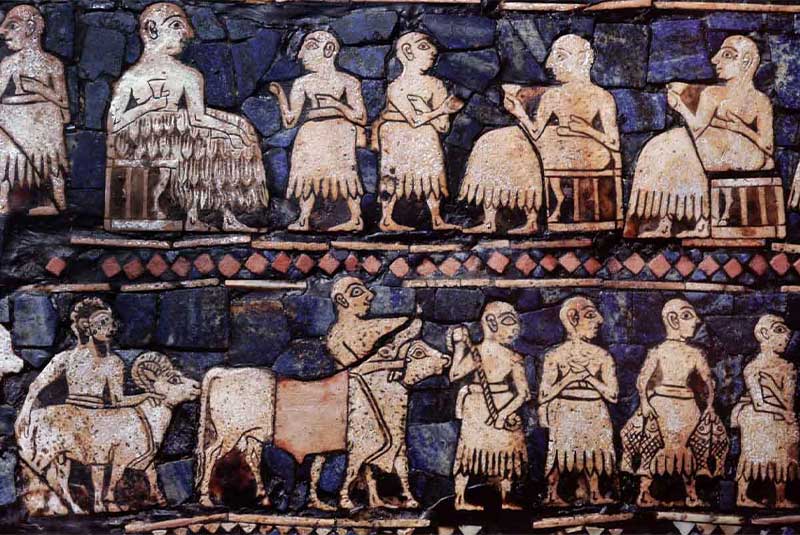
Eshkaft-e Salman (Izeh in Khuzestan province), The Relief of Shahswar (Izeh in Khuzestan province), Tchogha-Zanbil
previously, the ziggurat of Tchogha-Zanbil (Choqa Zanbil) was briefly mentioned, but this magnificent monument's position is definitely such that it deserves a part of this article.
Tchogha-Zanbil was first discovered as an ancient hill, and after exploring that hill, the huge monument of Tchogha-Zanbil was found. Tchogha-Zanbil, in the local people's language, means a mountain in the shape of a basket, which was named because it resembled a basket before the excavations. This place was a religious city in the Middle Elamite period, in the heart of which they built a shrine for the gods, and this hypothesis was confirmed by the temple's inscribed bricks and some contents of the Assyrian inscriptions about Ashurbanipal's campaigns.
The ziggurat was an artificial mountain in the heart of the plain of Susa, which provided the possibility of performing religious rituals and ceremonies. The base of the ziggurat is a square, each side of which is 105 meters, and its angles are aligned with the main directions. This 5-story building was 50 meters high during the flourish, but now only 25 meters remain. The difference between the ziggurat of Tchogha-Zanbil and Mesopotamian ziggurats is that in Mesopotamian ziggurats, each floor was built on the floor below. However, in this ziggurat, each floor starts from the ground level and includes the previous floor.

The walls of this ziggurat are made of raw clay, but the outer surface of the walls is covered with bricks. On some of these bricks, writings in Elamite cuneiform can be seen. In the middle of the side walls of the ziggurat, grand entrances were built, through which covered staircases led to the upper floors. Three staircases led to the first floor, where the crowd of worshipers was stationed. While the southwest entrance led to the top floor of the ziggurat, where the main temple was located by several side stairs, and their use was reserved for the first-class clergy or the ruler. An area of 300 x 400 square meters included this monument. Another wall with a length of about 900 to 1200 meters separated the area of the holy city. Finally, an outer fence was built around the city, which was more than 4000 meters long. The remains of this wall can still be seen. Tchogha-Zanbil Temple is one of the first buildings in Iran that was included in the World Heritage List by UNESCO in 1379 AD.
2. Median
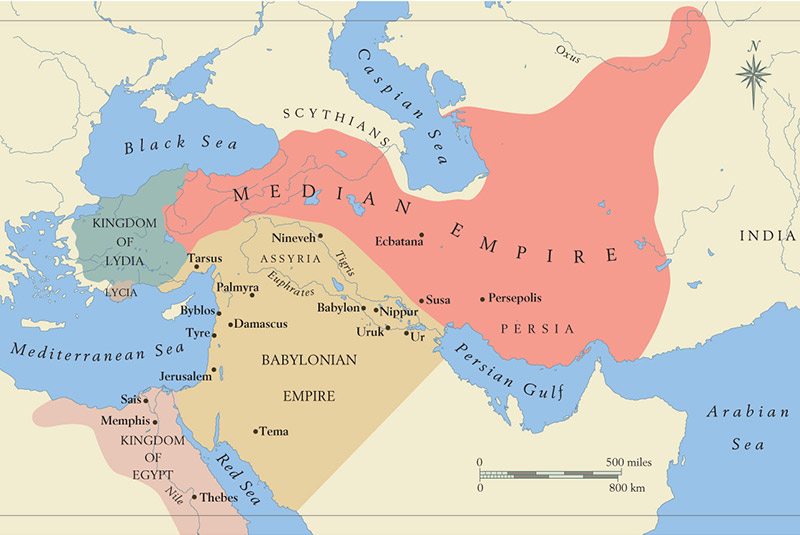
In 646 BC, the Assyrian King Ashurbanipal sacked Susa, which ended Elamite supremacy in the region. For over 150 years, Assyrian kings of nearby northern Mesopotamia were seeking to conquer the Median tribes of western Iran. Under pressure from the Assyrian empire, the western Iranian plateau's small kingdoms coalesced into increasingly more extensive and centralized states. In the second half of the 7th century BC, the Median tribes gained independence and were united by Deioces. In 612 BC, Cyaxares, Deioces’ grandson, and the Babylonian King Nabopolassar invaded Assyria and laid siege to and eventually destroyed Nineveh, the Assyrian capital, led to the fall of the Neo-Assyrian Empire. The Medes are credited with the foundation of Iran as a nation and empire and established the first Iranian empire, the largest of its day until Cyrus the Great established a unified empire of the Medes and Persians, leading to the Achaemenian Empire.
In the early 550s BC, an intelligent, talented, and charming Persian nobleman named Cyrus II launched a successful rebellion. He ended the rule of the Medes by capturing the Median fortress of Pasargad, which became known as Pasargad by Greek authors, and laid the first foundation stone of the great Persian empire.
Antiquities of the Median:
Nushijan Hill (near Malayer), Patape (near Malayer), Bābā Jān Tepe (Nurabad in Lorestan Province), Godin Tepe (Kangavar in Kermanshah Province), Teppe Hasanlu (Naqadeh in West Azerbaijan Province), Ozbaki Tepe (Nazarabad County in Alborz province), Qoli Darvish (Qom), Tepe Hegmataneh (Hamadan), Sialk Hills (Kashan), Essaqwand Rock Tombs (Harsin in Kermanshah), Goor-Dakhmeh Sahneh (Kermanshah province), Dokan-e-Davood Catacomb (Sarpol-e Zahab in Kermanshah province), Fakhrigah Rock Tomb (Mahabad in West Azerbaijan), Ghizghapan Catacomb (Sulaymaniyah in the Iraqi Kurdistan Region), 'Dā o Doḵtar’ Rock-cut Tomb (Fahlian in Fars Province).
3. Achaemenid Empire
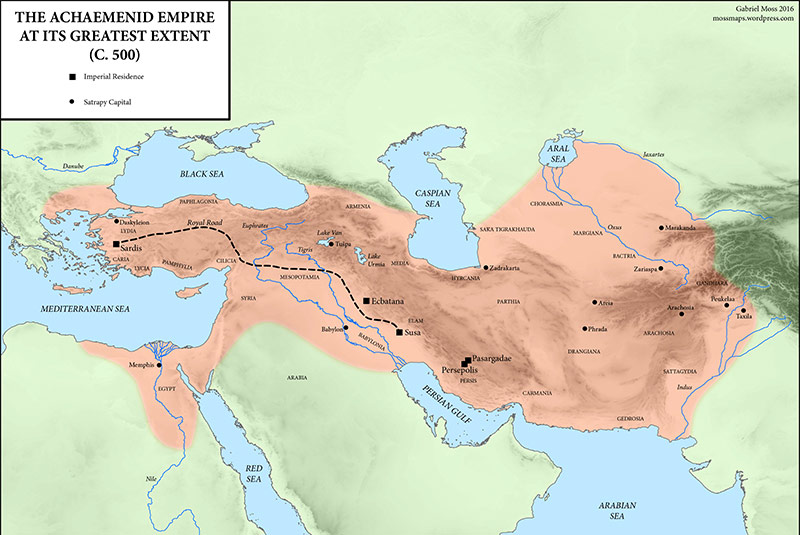
With the rise of the Achaemenid state (Persia), which Cyrus the Persians founded from the famous Achaemenid dynasty, Iran played a decisive role in world history. Iran bordered Greece in the Achaemenid era by conquering the eastern Greek cities and states. From this date, a kind of confrontation and conflict between the East (centered by Iran) and the West (led by Greece) was created. Of course, Greek historians and thinkers did not sit idle in the meantime. Those who called non-Greek nations, including Iranians, barbarians, expressed their hatred in books. With this view, many historical books were written, almost none of which are free of one-sidedness and hatred of Iranians. Therefore, citing such texts requires sufficient accuracy and caution and comparing them with archaeological data.
The two tribes of Medes and Parses entered the plateau of Iran from the West of Mazandaran Lake. The Medes settled around Lake Urmia, and the Persians, who were initially around this lake, were forced to migrate south due to the pressure of the Medes and Assyrians and advanced to Khuzestan. In this way, the Persians gained the land that became their permanent homeland in the subsequent developments. The land where Cyrus ended the rule of the Medes in 555 BC by capturing Pasargad, the Median fortress, laid the first foundation stone of the great Persian Empire.
After Ecbatana - the capital of the Medes - Babylon was also captured by Cyrus. Then he expanded his empire and reached the farthest parts of the world by 530 BC. In addition to his expertise and tact in political and military organization, Cyrus respected various beliefs and cultures. This is beautifully illustrated in the cylinder that he created.
Cambyses II, the son of Cyrus the Great, conquered Ancient Egypt. Since he became ill and died before, or while, leaving Egypt, stories developed, as related by Herodotus, that he was struck down for impiety against the Egyptian pantheon. Be that as it may, it led to a succession crisis. The winner, Darius I of Persia, based his claim on membership in a collateral line of the Achaemenid Dynasty.
Cyrus is indeed the founder of the Achaemenid government, but Darius undoubtedly brought stability and peace to the ruling empire. With his unique expertise, he implemented reforms and measures that strengthened the foundations of the newly established Achaemenid Empire. Among them, it is possible to mention the adjustment of taxes, the amendment of judicial laws, the establishment of the Immortal Guard, the minting of coins (coinage had already been invented over a century before in Lydia ca. 660 BC), the establishment of the new system, the invention of the ancient Persian script, the division of the country into 22 states, and the construction of a magnificent city called “Parse (Persepolis)”.
After the death of Darius in 486 BC, his son Xerxes ascended the throne. Being the son of Atossa, the daughter of Cyrus the Great, he had more legitimacy in this matter. He first suppressed the rebellion in Egypt, then invaded Greece with a large army. Despite the destruction of many armies, Xerxes conquered Greece at the pass of Thermopylae. Athens fell, and the Acropolis was burned in the fire of Xerxes' wrath. Xerxes, the King's troops, destroyed many cities, villages, farms, and temples. The statue of Greek holy gods was taken to Iran. This act aroused the Greeks and ignited the flames of their revenge, and finally, this revenge reached its peak in Alexander's attack on Iran and the conquest of Persepolis in 330 BC.
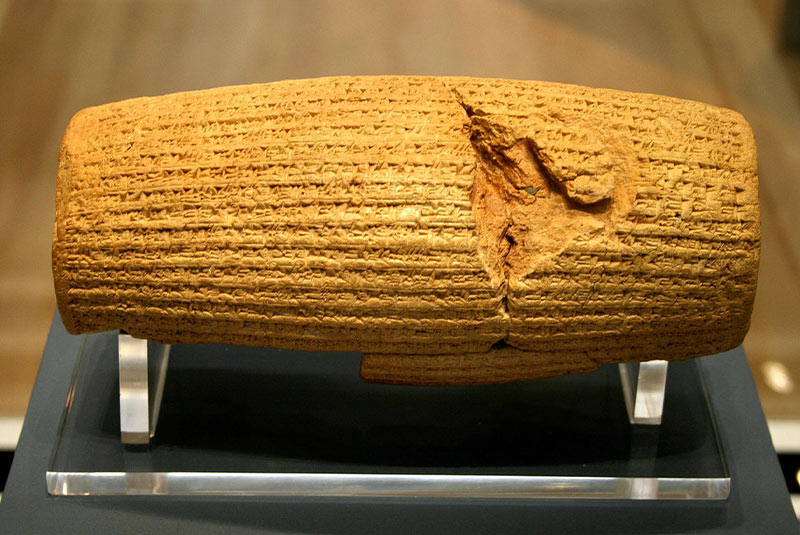
It is essential to mention that King Xerxes violated all the traditions and beliefs of the Iranian empire that Cyrus the Great had shown during the conquest of cities, and Xerxes' performance in Athens was far different from Cyrus's performance in Babylon. It is clear that the West has never forgiven Xerxes' invasion of ancient Greece.
Little by little, during the time of the successive kings, the Achaemenid government became weak and then weaker. And finally, it was Darius III who took the throne. But during the reign of this King, first Philip of Macedon in 336 BC and then Alexander of Macedon in 334 BC marched to Iran. The Iranian troops were defeated in the three famous battles of “Granicus”, “Issus,” and “Gaugamela”. The King of Iran fled to the state of Parthia (northeast) of Iran. But he was killed there by the governor of Balkh; thus, the Achaemenid dynasty fell in 330 BC.
The names of the tribes included in the early inscriptions of this government are almost no different from their names reflected in the later inscriptions. This shows that the Achaemenids maintained the unity and integrity of their territory until the end of their reign.
Antiquities of the Achaemenid Empire:
Pasargad (Fars province), Apadana Castle Shush (Khuzestan Province), Dahane Gholaman (Zabol in Sistan va Baluchistan province), Persepolis (Fars province), Naqsh-e Rostam (Persepolis), Bisotun (Kermanshah Province), Inscription of Darius in Shush, Darius the Great's Suez Inscriptions (Egypt), Ka'ba-ye Zartosht (Zangiabad in Fars province), Gur-e-Dokhtar (Bushehr), Charkhab Palace (Dashtestan county in Bushehr province).
4. The Hellenic Conquest
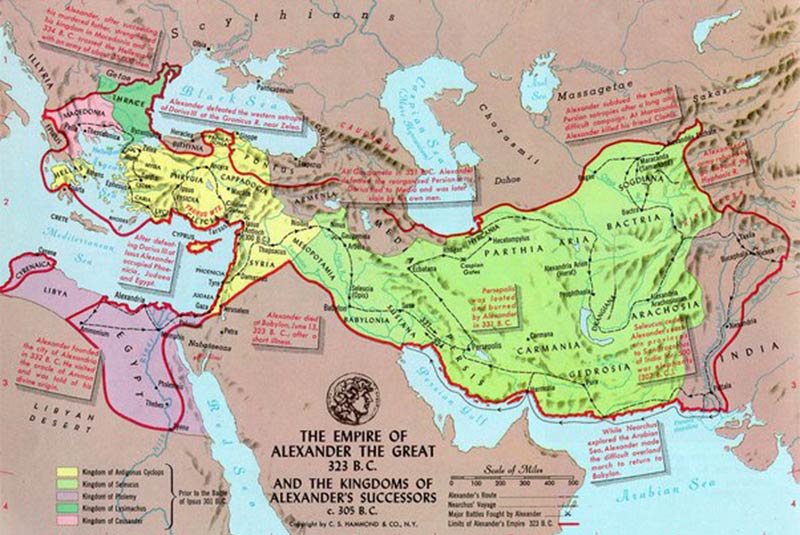
The vast Achaemenid empire's prosperous cities, magnificent monuments, exquisite works, and diverse cultural traditions encouraged Alexander to march to Iran. He advanced to the heart of the Persian Empire by conquering cities like Babylon and Susa. Of course, the most important conquest of Alexander was the conquest of Persepolis (the city of the Persians). The conquest of Persepolis brought Alexander a treasury whose wealth was legendary and incredible in the Greek world and whose exquisite and delicate objects had been collected during the life of an old empire from the spoils and gifts of the East and the West. But apart from the captured loot, what could quench this thirst for revenge was burning this rich and magnificent city.
After the fall of Iranian cities, Alexander turned toward India. However, after a while, due to the attrition of his fighting forces, he returned to Iran and chose Babylon as his new eastern capital. This choice was because Babylon could connect the West and East of Alexander's territory better than any other city. He did not only think about the geographical connection of the two worlds, East and West, but his marriage with Roxana, the daughter of Darius III, and his generals with daughters from the Achaemenid family or other great Persian families, and his soldiers with Iranian daughters should be considered as the foundation for the cultural fusion of these two realms. But the early death of Alexander destroyed all his plans (323 BC).
Now, any lover of power and royalty could claim succession in this vast world without a leader and a king. Due to this, there were years of conflict between these claimants to the throne for years, until new governments were established over the half-completed empire of Alexander. Thus, Lysimachus became the King of Asia Minor (modern-day Turkey). Cassander the King of Macedonia and Greece, Ptolemy the King of Egypt, and Seleucus the King of Asia (Iran and Mesopotamia).
From 311 to 304 BC, Seleucus humiliated his enemies with successive battles and finally made everyone in Babylon and Iran obey him and his family. He was officially crowned in 305/304 BC. And in this regard, a new government named Seleucid was established, which ruled a part of the western part of the Achaemenid Empire until 65 BC.
5. The Seleucid Empire
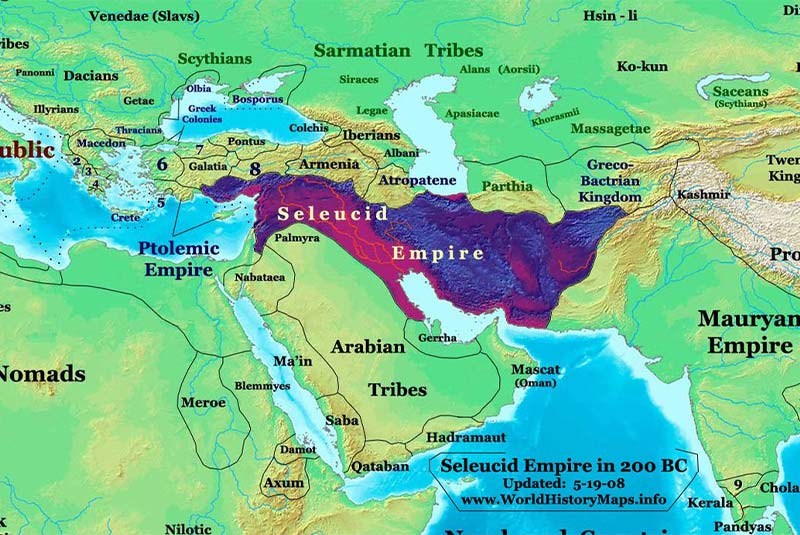
Alexander’s empire broke up shortly after his death, and Alexander’s general, Seleucus I Nicator, tried to take control of Persia, Mesopotamia, and later Syria and Asia Minor. His ruling family is known as the Seleucid Dynasty. However, he was killed in 281 BC by Ptolemy Keraunos. Greek language, philosophy, and art came with the colonists. During the Seleucid Dynasty, Greek became the common tongue of diplomacy and literature throughout Alexander's former empire.
The Parthian uprising began in the eastern regions of Iran. However, with the expansion of their power and influence in the West, the Seleucids were forced to retreat further toward Syria. Until 247 BC, Iran was completely removed from their 65-year rule. With the formation of the Parthian government, the progress of Greek culture was restrained, and an opportunity was provided to establish a balanced hybrid friendship between the tendencies of ancient Greek and the East.
6. Parthian Empire
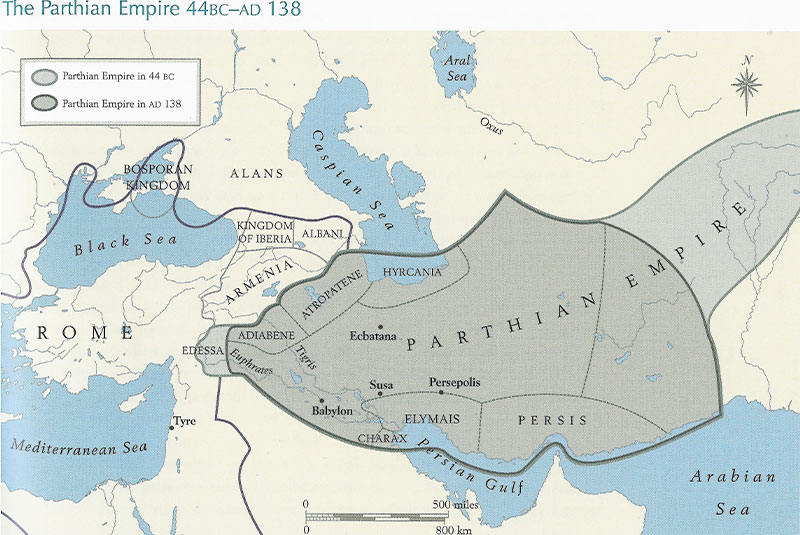
Parthians were Aryan tribes who lived in the Parthia region. Around 427 BC Ashk (Arshak or Arsaces) established the Parthian dynasty in Parthia. By confining the Seleucids to Syria and many wars with the Romans, they partially restored the Achaemenid Empire's borders. Apart from geographical development, the Parthians also made great efforts in the field of deepening the Iranian culture. By mixing the cultural elements of two different realms, East (Iran) and West (Greece and Rome), they created many transformations in fields such as art, religion, and literature in Iran.
It is worth mentioning that the Parthians is the second native dynasty of ancient Iran (Persia). Despite the long-term rule of the Parthians (from 247 BC to 224 AD), our knowledge of them is much less than that of their predecessors, the Achaemenids, as well as their successors, the Sassanids.
During the Parthian period, there were always conflicts between the Romans and the Parthians, and also, at the end of the Parthian period, there were internal conflicts over power. But fate was written in such a way that the fall of the Parthians was not at the hands of their old enemy, the Romans. But an Iranian ruler named Ardashir dealt the last blow to the body of this worn-out tree by claiming to revive the Zoroastrian religion. With the death of Ardavan, the last survivor of the Parthians in Ctesiphon, in 228 AD, the great Parthian empire collapsed and was replaced by a new government called the Sassanids.
Antiquities of the Parthian Empire:
Nisa (near the Bagyr neighborhood of Ashgabat, Turkmenistan), Khajeh Mountain (in the middle of Lake Hamun, in Sistan and Baluchestan Province), Anahita Temple (Kangāvar in Kermanshah Province), Ctesiphon (near Baghdad), Rashkan Castle (Dej-e Rashkaan) Ancient Ray (Ray), Zahhak Castle (Hashtrud in East Azerbaijan Province), Parthian reliefs in Biston mountain (Kermanshah).
7. Sassanid Empire
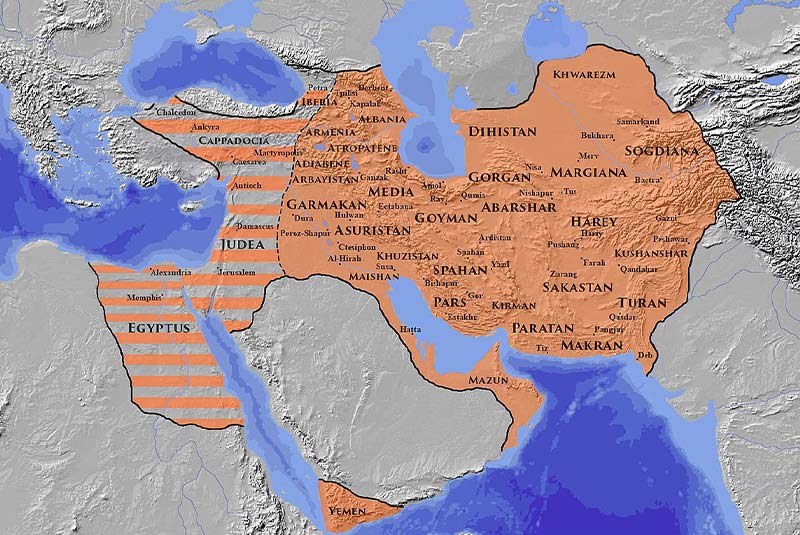
By overthrowing the Parthians, Ardashir established a new government that lasted more than four hundred years in Iran. The government of Iran during the Sassanid era reached such a position in terms of military, economic, and cultural that is rarely seen in the history of this country. The Achaemenid Empire's territory was much larger than that of the Sassanid Empire, but the Achaemenid Empire was so defeated by a smaller land, namely Greece, that Western cultural dominance silenced their history and culture for decades. Due to the lack of internal cohesion, the Parthian government did not have the same power as the Sassanids. But it was the Sassanids who fought against the most powerful and civilized country of the era from the West for four hundred years, as well as they stood firm against the semi-civilized desert tribes from the East and north and kept the country safe from their raids. These were the foreign policies of Sassanids. Inside the country, they strengthened the cultural and artistic foundations of the society so much by creating coherent organizations that even after the collapse of the country's political structure, culture and art continued their natural course like a raging river. Here, only the great as well as famous Sasanian kings, will be mentioned.
After killing Ardavan and defeating other claimants to the throne, Ardashir declared himself the “Shahan Shah of Iran”. The oldest document of this naming is the Naqsh-e Rostam inscription.
After Ardashir's withdrawal from political activities, his son Shapur took over the affairs. Shapur brought peace to the eastern borders by marching to the east. After fifteen years, he engaged the Romans again and achieved significant success. The construction of the city of Bishapur and the sculpting of the Tang-e Chogan relief is the result of this victory.
Finally, after years of the incompetence of the kings after Ardashir and Shapur, the elders made a young child named Shapur, known in history as Shapur II, as King, who reigned for seventy years (from 309 to 379 AD). During his childhood, the Arabs invaded and infiltrated the country. But by driving them out of Iran, Shapur showed that even as a child, he was worthy of kingship.
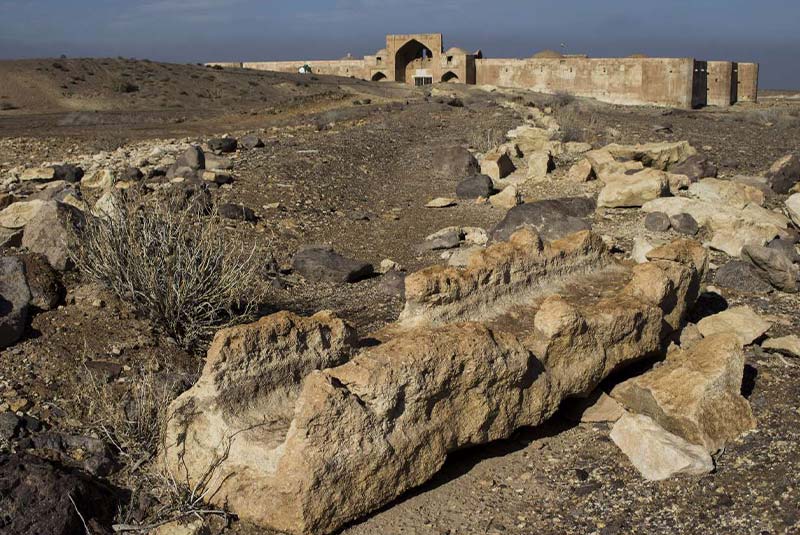
Bahram V, a famous Sassanid King known as the “Gor” because of his desert-dwelling upbringing, was fond of hunting, pleasure-seeking, and socializing with women. Stories and poems were made from his attributes, the best example of which is the legend of “Haft Gonbad,” written by Nizami Ganjavi. The stories that were told about this fun-loving King did not remain in the fence of the books but also decorated the surfaces of the palaces of the post-Islamic sultans.
The next King mentioned here is Khosrow I, known as Anushirvan, who can undoubtedly be considered one of the most fabulous kings of Iran due to his internal reforms and overseas victories. The geographical territory of Iran during the time of this King had a rare size. Finally, Anushirvan died in 579 AD after reigning for 50 years.
Also, Khosrow II, known as Khosrow Parviz, despite the difficulties he faced from the beginning of his reign, presented the last great ancient monarchy. However, to maintain and consolidate this monarchy, he also determined the fall of the empire of his ancestors with self-destructive wars and heavy taxes. The events that happened during the time of Khosrow Parviz eventually caused the elders to attack him and put him in prison. In the end, they killed him in 327 AD.
After the death of Khosrow Parviz until the reign of Yazdgerd III, ten kings ruled Iran, and even two of Khosrow Parviz's daughters named Azarmidokht and Boran sat on the throne and reigned for a short time. However, with the coronation of Yazdgerd III in 632 AD in Atashkdeh (fire temple) or Anahita temple in the city of Istakhr, the confusion and the dispute over succession subsided. But a more fundamental problem emerged: the attack of Muslim Arabs on Iran.
After the death of Prophet Muhammad, Muslim Arabs attacked Iran and Rome. And in the battle of al-Qadisiyyah (in 636 AD), they inflicted a decisive defeat on Yazdgerd III's army. With the death of Yazdgerd III by a miller in Merv, the powerful and glorious Sassanid rule ended. Surprisingly, the fate of the last kings of the Achaemenid and Sassanid dynasties is similar to each other: both were killed while fleeing to the East and by Iranian elements, not by Greeks and Arabs. Darius III by the ruler of Balkh, Yazdgerd III by an anonymous miller in Merv!
It is worth mentioning that, The Sassanid dynasty's unique and aristocratic culture transformed the Islamic conquest of Iran into a Persian Renaissance. Much of what later became known as Islamic culture, architecture, writing, and other skills were taken mainly from the Sassanid Persians into the broader Muslim world.
Moreover, the Sassanian language was Pahlavi, which is the root of modern Farsi, and their capital was Ctesiphon in modern Iraq. Ardashir’s Palace at Firuz Abad, Bishapur city, the giant statue of Shapur I, and the Bam citadel are among the most important monuments remaining from the Sassanid period.
Antiquities of the Sassanid Empire:
Ardashir-Khwarrah (Firuzabad County in Fars Province), Bishapur (near Kazerun in Fars Province), Ctesiphon, Sarvestan Palace (Sarvestan in Fars Province), Khosrow Mansion (Qasreshirin in Kermanshah Province), Sassanid inscriptions in Naqsh-e Rostam and Taq-e Bostan and Ka'ba-ye Zartosht.
II. Iran History: After Islam
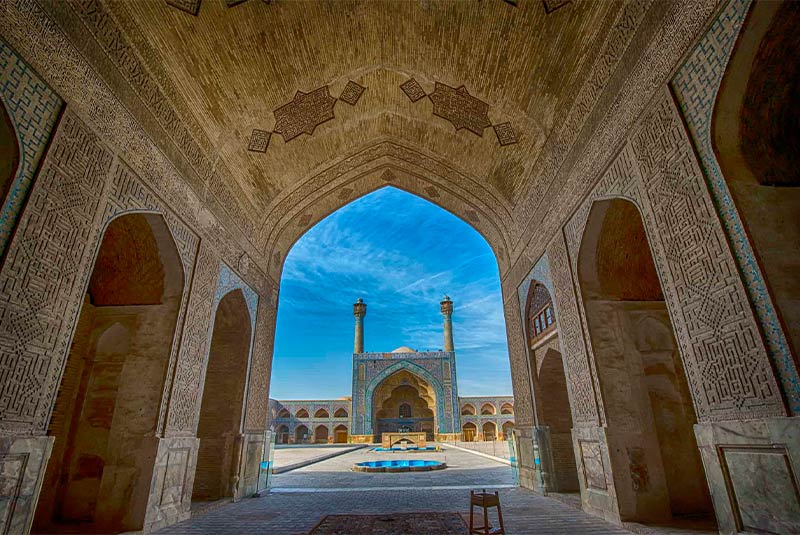
By accepting Islam, Iranians aspired to improve their social status and enjoy equality, but with the completion of conquests and the arrival of the Umayyad Caliphate, the purity of intentions and religious fervor, and simplicity of the early followers were diminished, and ambition, wealth seeking, and other purposes came to the fore. The Iranians became disillusioned, and the gap between the new Muslims and the Tazis, who were attached to their old beliefs and traditions and despised non-Arabs, deepened. Many subsequent uprisings by different groups of Iranian people were the result of this behavior.
After the conquest of Iran, Arab desert dwellers, especially from Kufa and Basra, which were Iran's neighbors, suddenly poured into Iran. At first, the Iranians did not warmly accept the arrival of such immigrants. However, the Arabs established their social base by making quick relationships with the nobles of different regions, as well as making friendly relations and marrying residents.
Abu Muslim al-Khurasani took advantage of the anti-Umayyad sentiments of Iranians and the differences between the Arab tribes settled in Khorasan, in a short time he was able to rule over the whole of Khorasan. Finally, in the war that took place between the army of Khorasan and the forces of Marwan - the last Caliph of the Umayyad Caliphate - in northern Iraq, the Umayyad army was defeated, and the Umayyad Caliphate, which was like a kingdom, ended. In this way, the ninety-year rule of the Umayyad dynasty came to an end, and the rule of the Abbasids began. Now is the time to learn more about the Iranian government at, the same time as the Abbasids.
1. Tahirid Dynasty (821 - 873 AD)
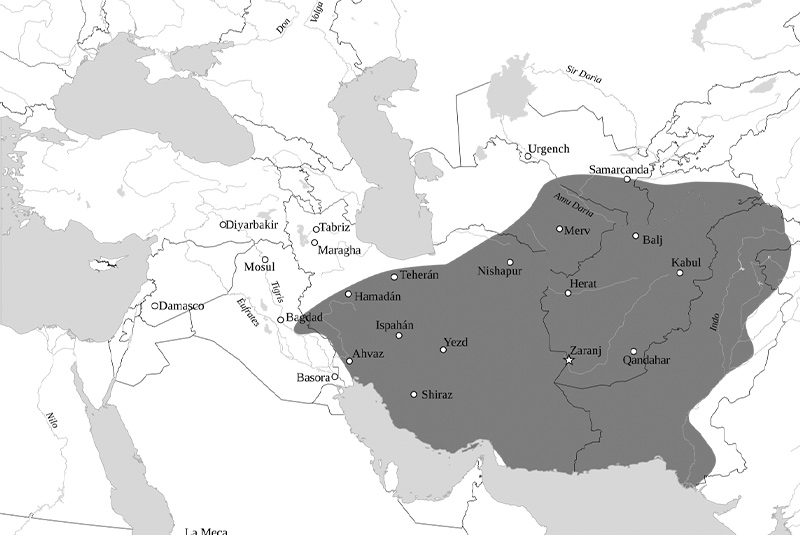
Tahir ibn Husayn founded the first Islamic government during the Abbasid Caliphate in Iran. He thus removed a part of the land from the direct supervision of the Caliph of Baghdad as a type of hereditary government until Yaqub Leith marked the end of this rule.
The Tahiri rulers paid particular attention to the peasants' welfare and tried to ensure their comfort with their actions. Among their most important steps in this field were the creation of numerous aqueducts (Qanats) and the prosperity of Khorasan agriculture. Some aqueducts in the Khorasan region are still known as “Tahiri Qanats”.
2. Saffarid Dynasty (873 - 1006 AD)
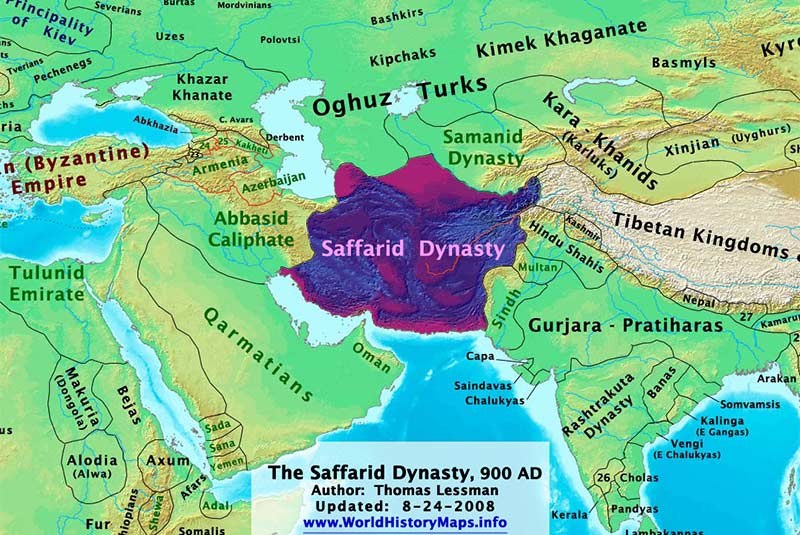
If we consider Tahir the founder of Iran's first semi-independent government, Yaqub Leith is the first person who established an independent government from the Abbasid Caliphate. This government destroyed the Tahirid government despite the Caliph's wishes and refused to obey the Abbasid caliphs. Although the caliphs hated Yaqub and his brothers, they were popular among the people of Iran, especially the residents of Sistan.
In the war between Ayaran and Khawarij, Yaqub conquered Sistan and overthrew the Tahirid government in 873 AD by occupying Neyshabur - the seat of Muhammad ibn Tahir. The name of Yaqub and other government rulers is still alive in the memories, not because of political conflicts with the caliphs but due to their support for Persian writers and poets.
3. Samanid Dynasty (892 - 998 AD)
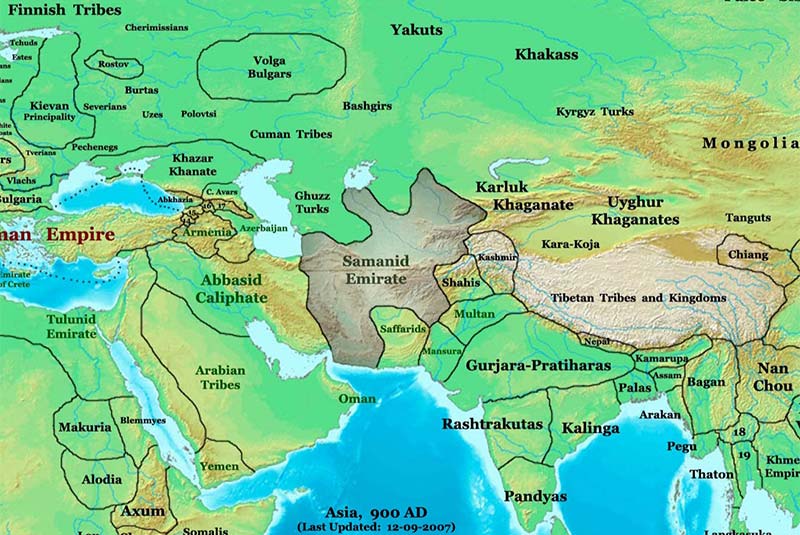
Saman was a fertile region in Afghanistan, where a farmer named Saman ruled that land with Zoroastrian traditions. Bukhara was chosen as the capital for the first time by Ismail, one of the descendants of Saman, and it prospered from that time. In 1004, the Samanid government ended, and their territory was divided between the Ilkhanids and Ghaznavids.
Like the Tahirids, the Samanids supported the Abbasid caliphs and sent heavy tributes to the court of the caliphs. Of course, this obedience ended for their benefit; they both made their position acceptable and pleasant for Muslims and paid particular attention to the revival and preservation of Iran's ancient ethnic heritage. The fact that the rulers of this dynasty attributed themselves to the famous Sassanid general Bahram Chobin indicates their friendship with Iran.
Bukhara became one of the important centers of culture and knowledge from 913 to 942 AD. Also, many books on medicine and pharmacy were written during this period, and the Bukhara court library was very famous. Abu Ali Sina benefited from this library in his youth. The Samanian court was a refuge for Persian poets and writers. Among them, we can mention Ferdowsi (the composer of the Shahnameh) and Rudaki, the first major poet to write in New Persian. They were the ones who, with the material and spiritual support of the court, were able to save the heritage of ancient Iran from the danger of oblivion and complete destruction.
Antiquities of the Samanid Dynasty:
Ismail Samani Mausoleum (Bukhara in Uzbekistan).
4. Ziyarid Dynasty (928 - 1043 AD)
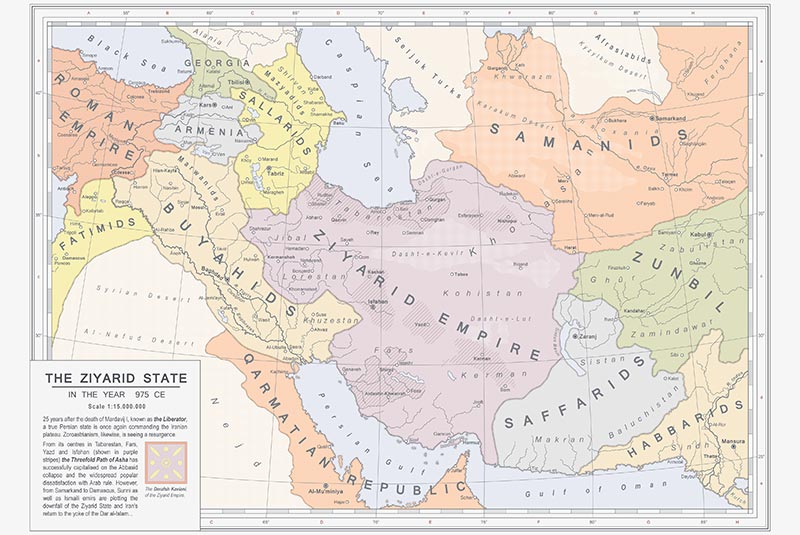
Ziyarian Iranian family was from the Mazandaran region, and they were able to rule parts of Iran for more than a century. Tabaristan and Gilan had maintained their semi-independent rule since the Sasanian era. After the Muslim Arabs dominated most parts of Iran, these areas were still immune from their attacks. Mardavij from the Ziyarian family, who was first in the service of the Samanids, eventually rebelled against them and was able to establish a government that became known as Ziyarids. After the conquest of Isfahan, he dreamed of attacking Baghdad and was about to be crowned in Ctesiphon - the capital of the Sassanids - when Turkish slaves killed him in Isfahan.
5. Buyid Dynasty (934 - 1057 AD)
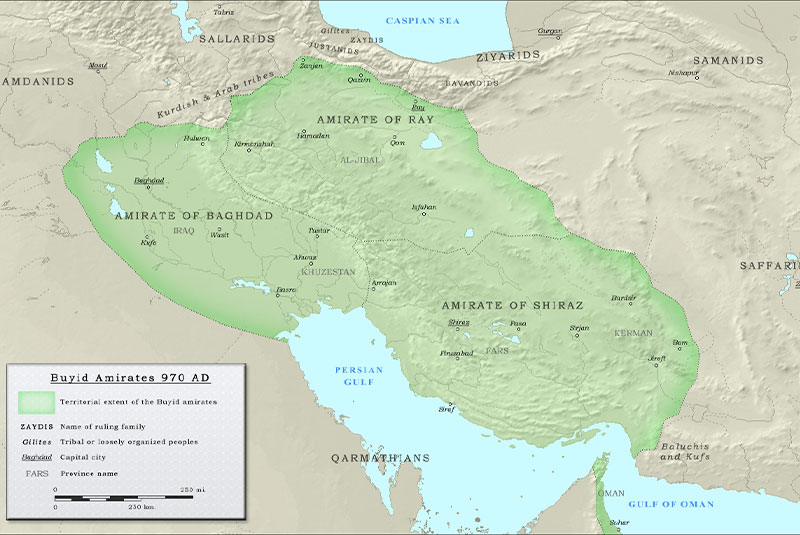
Ali, Ahmad, and Hassan were three sons of a fisherman named Booye who lived in the Daylam area of Gilan. These three Daylami brothers served Mardavij Ziyari and played a significant role in his conquests. After Mardavij was killed, the Turkish slaves fled due to the fear of Daylamites, especially Ali, and thus, the field was left empty for the invasion of Daylam Turks.
In general, Al-e Booye can be divided into three relatively independent branches: 1- The group that ruled in Ahvaz, Iraq, and Kerman 2- Those who have been in Iraq and Fars 3- Those who governed in Kerman and Fars.
The last emir of the Buyid dynasty in Ray, due to his young age, his mother practically ruled his territory. Sultan Mahmud of Ghazni refrained from attacking Ray and conquering that city for many years because of the reign of this woman. The last Buyid emir in Fars and Khuzestan was captured by Tughril Seljuk in 1055 AD, and at this time, Al-e Booye's rule practically ended.
Antiquities of the Buyid Dynasty:
Band-e Amir (Dam of the Amir) or Band-e Azodi (near Shiraz)
6. Ghaznavid Dynasty (961 - 1040 AD)
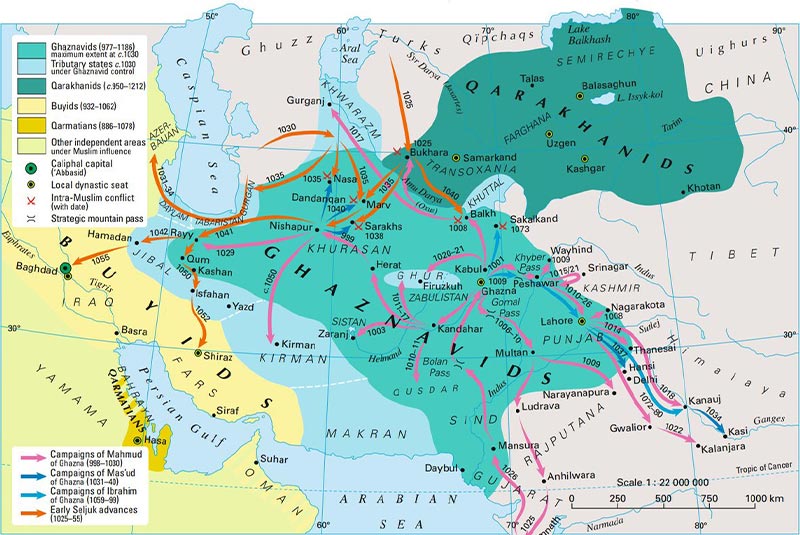
Alp-Tegin and Sabuktigin were of Turkish descent and were in the Samanid court. Alp-Tegin took advantage of the Samanid's weakness and declared his independence from the Samanid government by conquering Ghazni. Hence, a small government was formed in the south of the territory of the tremendous Samanid government. But it was Sabuktigin, the son-in-law of Alp-Tegin, who expanded the territory of Ghaznavids due to frequent attacks on the lands of Sindh and India. For this reason, the real founder of the Ghaznavids is considered Sabuktigin. He was succeeded by his son Mahmud, the first Muslim ruler who took the title of Sultan.
After seizing the throne, Mahmud justified his invasions of the Shiite areas intending to clear them of infidels and corruptors. In addition to the material benefits of Mahmud's campaigns, they also brought him religious legitimacy. But Mahmoud knew that for the continuation of the government, it was impossible to rely only on religious legitimacy, and he must be popular and acceptable among the people of Iran. His attention to the Shahnameh and providing the conditions for writing this epic was for this purpose. This Turkish King was not so attached to the actions of the previous kings of Iran, but with political acumen, he pretended to be interested in the history and culture of Iranians.
The subsequences of these wars were determined when the Seljuk Turks attacked, so the people welcomed these new arrivals with a kind of satisfaction and joy. Besides Ferdowsi, Abu Rayhan Al-Biruni, and Bayhaqi, other poets and writers such as Masud Sa'd Salman also performed in the court of Ghaznavid kings. The end of this government happened not only at the hands of Iranian governments but also by their fellow races, the Seljuk Turks.
Antiquities of the Ghaznavid Dynasty:
Ghazni Minarets (Ghazni in Afghanistan), The minaret of the Tarikhane mosque (Damghan in Semnan Province), Chahe Caravansary (Sarakhs in Razavi Khorasan Province)
7. Seljuk Empire (1037 - 1194 AD)
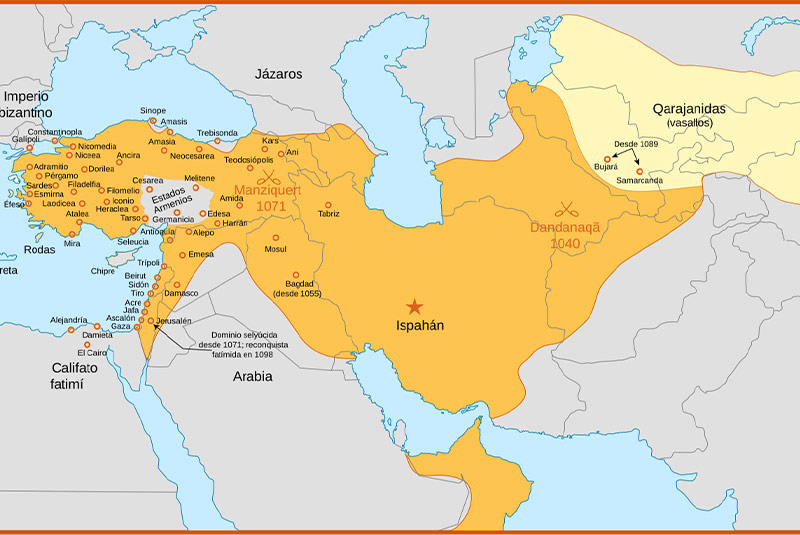
During the time of Sultan Mahmud of Ghazni, the Turks of Ghaz had settled in the vicinity of Sarakhs and Abiward with his consent. The leader of the Turks named, Tughril, facing the weakness of the Ghaznavids due to the dispute over Mahmud's succession, started his activities to penetrate the Iranian plateau and finally founded his government in 1037 AD. From this date until 1194 AD, a government was formed in Iran, which are called Seljuks based on the name of the ancestor.
The government of the Seljuk Turks is the first powerful, long and extensive government after Islam. One of the reasons for the consolidation of the Seljuk rule can be this: they took help from the Iranian men's government to administer this vast region - from India to the eastern coast of the Mediterranean. One of their famous ministers was Nizam al-Mulk Tusi. The reasons for the extinction of the Seljuk government are briefly as follows: first - the increase in power and political influence of the Abbasid Caliphate; second - the consolidation of the power of the Turkish and Atabakan rulers in the various western provinces of the Seljuk Empire and third - the reduction of the real power of the Seljuk sultans due to the existence of disunity and significant differences between them.
Antiquities of the Seljuk Dynasty:
Alamut Castle (Qazvin province), Jameh Mosque of Isfahan, Kharaqan Towers (near Qazvin), Toghrol Tower (Rey), Sharaf Caravanserai (Khorasan)
8. Ilkhanid Dynasty
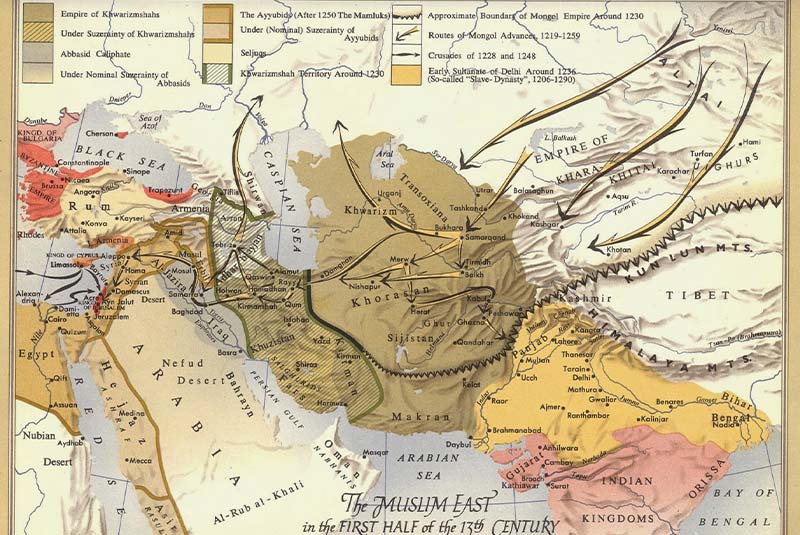
The land of Mongolia, located in West Asia, was the place where primitive and nomadic people lived, who had no other role in history than war, hunting, aggression, plundering caravans, and destroying the manifestations of civilization. With the emergence of Genghis Khan and the formation of the Mongol Empire, significant changes and transformations occurred in the way of life of the Mongols, and the two ancient civilized states of Asia, China and Iran, led the desert dwellers of Central Asia towards civilization and urbanization.
After subjugating all the Mongols, Genghis Khan noticed the outside world, especially Iran. In that period, Iran was materially and spiritually rich but tense and fragmented. The Khwarazmshahis ruled parts of it, the Ismailis dominated a part of it, and the other part was under the rule of the Abbasid caliph. Genghis Khan, who had a plan to take over the world, took full advantage of the conflicts in the land of Iran and launched extensive attacks against Iran. In the first period of the conquest of Iran, the Mongols attacked Iran's cultural arena only with the intention of looting and destroying Iranian civilization and culture. After widespread looting, killing, and collecting war spoils, they returned to their homeland - Mongolia.
The second period of Mongol rule in Iran begins with the second campaign of Hulagu Khan to Iran for its complete conquest. Unlike the previous period, the Mongols stayed in Iran this time. Then, from the very beginning, the managers and agents of the Khwarazmshahi court cooperated with the Mongol conquerors, like the Turkish and Arab conquerors before, and they reached high positions, even the ministry of Ilkhanids. During this period, the Mongol Empire was dissolved into the two ancient cultures and civilizations of that era, China and Iran, and the Ilkhanid dynasty was established in Iran.
Antiquities of the Ilkhanid Dynasty:
Silk Road, Soltaniyeh (Zanjan), Rab'-e Rashidi (Tabriz)
9. Timurid Empire
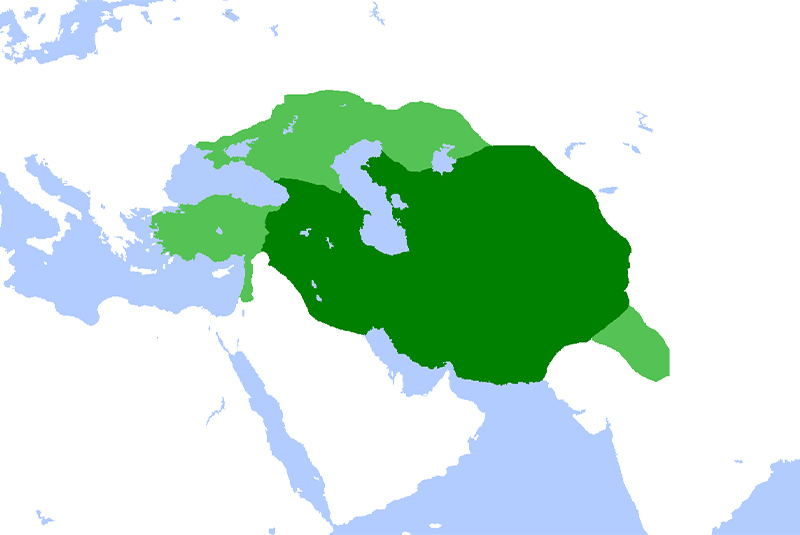
Between the extinction of the Mongols and Timur Gurkani's attack on Iran, this land underwent many changes, disturbances, and chaos. Finally, Timur came to Iran and destroyed all the small and big dynasties and dominated all of Iran. Like Genghis's attack, Timur's attack was also accompanied by burning, killing, and destruction. However, it did not take long before he and especially his successors bowed and surrendered to the greatness of the culture and civilization of this land. Then the flourishing of arts, knowledge, and sciences appeared again.
The Timurid era can be undoubtedly one of the most critical eras in world history, and the generation of Timur's successors, especially in Iran, can be considered one of the most prominent periods in the history of this land. Although during the period of Timur, many cities fell from prosperity due to frequent campaigns and conquests, Samarkand - his capital - became the epitome of the architectural art of Iran and other conquered countries.
Antiquities of the Timurid Empire:
Gur-e-Amir (Samarkand in Uzbekistan), Samarkand Jame' Mosque, Goharshad Mosque (Mashhad), Khargerd Ghiasieh School, Shah Mosque (Mashhad), Dodar Madrasa, Gawhar Shad Mausoleum (Harat), Mevlana Mosque.
10. Safavid Empire
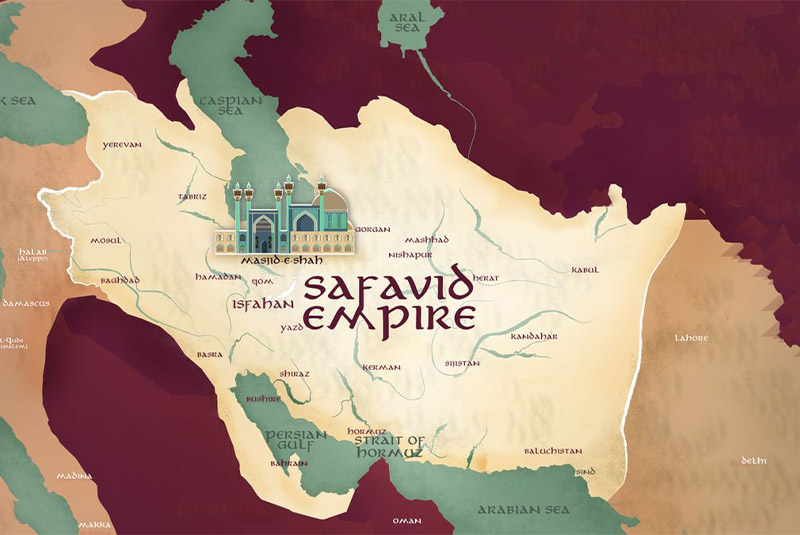
The formation of the Safavid dynasty in Iran may be considered one of the most extended and most fascinating chapters in the history of Islam and Iran; Because the Safavid era is one of the eras in which there was relatively centralized power and, as a result, public security. During this period, the artist or any other cultural person is busy with work and has no fear of invasion and attack by aggressors[16]. Perhaps because of this security, the 16th and 17th centuries have been considered the flourishing period of Islamic art.
The Safavids called themselves the descendants of Sheikh Safi-ad-din Ardabili (1252-1334 AD), who popularized the Sufi profession in Ardabil. Sheikh Safi-ad-din lived in a monastery in Ardabil. Until the death of Shah Ismail's father, that monastery was considered the headquarters of the leaders of the Safavid Sufis. Therefore, Ardabil is important as the origin of the Safavid dynasty.
Ismail established the Safavid dynasty and, within a decade, brought all of Iran under his rule. The Ottoman sultans, who were at the peak of their military power in the 16th century, were considered dangerous enemies of the Safavids. For this reason, later, the Safavid capital was moved from Tabriz, a vulnerable city subject to enemy attack, to Qazvin (1555 AD) and then to Isfahan (1597 AD).
The reign of Shah Abbas I, which was almost parallel to the rule of great rulers such as Elizabeth I, Philip II of Spain, Ivan the Terrible, the emperor of Russia, and Akbar, the Mughal emperor of India, was the peak of Safavid political power as well as civilization and culture. Examples of its most outstanding achievements in the field of art can be seen in the splendor and beauty of the architecture of this age in Isfahan.
After the death of Shah Abbas II in 1666 AD, a noticeable weakness was observed in the personal characteristics of the Safavid kings. Therefore, the Safavid ruler of Afghanistan declared himself independent in the early 18th century. In 1722, his son, Mahmud, rushed to Iran. The Safavids could not stand against him, and the Afghans controlled most of Iran until the rise of Nader Shah.
Antiquities of the Safavid Empire:
Jame Abbasi Mosque (Isfahan), Sheikh Lotfollah Mosque, Bazaar of Isfahan or Gheysarie Bazar, Ali Qapu
11. Afsharid Empire
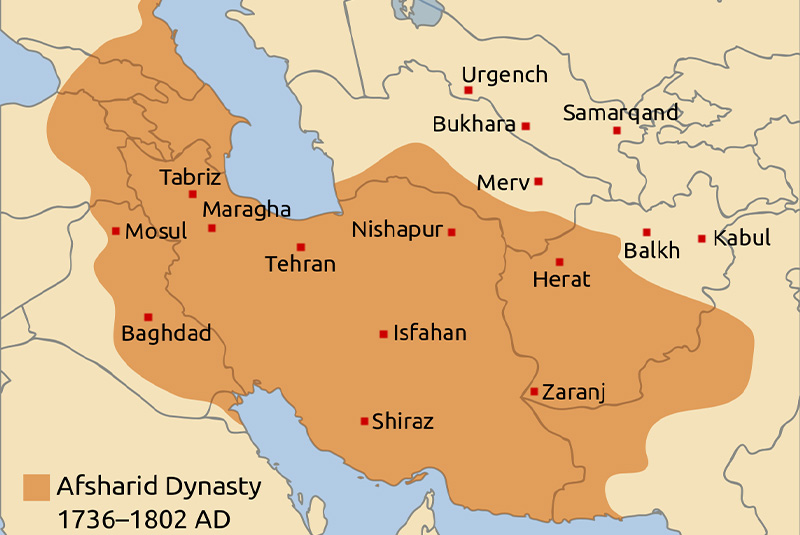
With the invasion of Afghans to Iran, years of death and bloodshed began, which continued until the time of Fath-Ali Shah. The city of Isfahan and its treasures were looted, and the fertile culture of Iran was dying. However, with Nader's entry into the field of conflicts and his clever measures, the foreigner's hand was shortened from Iran, but it is a pity that his actions were not stable and profound. There is no accurate information about Nader's ancestry, birth, and life until the age of forty[18]. Nader was the head of the Afshar tribe and the Afsharids were a tribe of Turkmen who lived in the north of Khorasan. He came to power during the time of Shah Tahmasp II Safavi and in his service.
Nader gradually cleared the soil of Iran from the presence of Afghan invaders. Until he officially proclaimed himself King in 1735 AD. But finally, in 1747 AD, some Afshari and Qajar chiefs rushed to his tent and killed him. Eventually, Agha Mohammad Khan Qajar, who had expanded his power from the north of Iran to the East in 1795 AD, removed the power of the Afsharians and ended their rule. It is worth mentioning that the Afsharid period, which is mainly related to Nader Shah's active life, is basically so short that if Nader and his successors wanted to bring about significant social and cultural developments and changes, they would not have been able to do anything.
Antiquities of the Afsharid Empire:
Khorshid Palace (Kalat Nader city in Khorasan Razavi Province), Arghavanshah Darband Rampart, Blue Mosque of Gonbad (Sarakhs)
12. Zand Dynasty
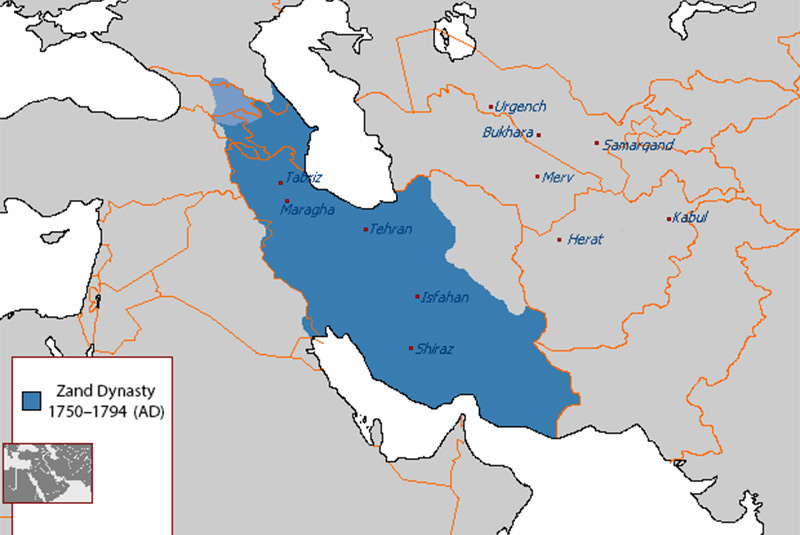
In the chaos that arose after the death of Nader Shah, various military leaders came to power in the provinces of Iran. In Mazandaran, the Qajars maintained their power base. In the south of Iran, power was first in the hands of Ali Mardan Khan Bakhtiari. He captured Isfahan and elected one of the Safavid princes named Shah Ismail III to the throne (1754 AD). Mohammad Karim Khan Zand was the general of Ali Mardan Khan.
When Ali Mardan Khan was killed, Mohammad Karim Khan made himself the sole ruler of the south. In 1765, when all of Iran (except Khorasan) was under his command, he made Shiraz the capital. During the last fifteen years, he ruled with kindness, justice, resourcefulness, and benevolence and settled Shiraz. The considerable growth and transformation of Isfahan during the time of Shah Abbas were manifested in Shiraz during the time of Mohammad Karim Khan Zand on a smaller scale. The country prospered under his rule, and trade relations between Iran and Britain were established through Bushehr and the Persian Gulf.
Antiquities of the Zand Dynasty:
Tomb of Hafez and Saadi (Shiraz), Arg-e Karim Khan
13. Qajar Dynasty
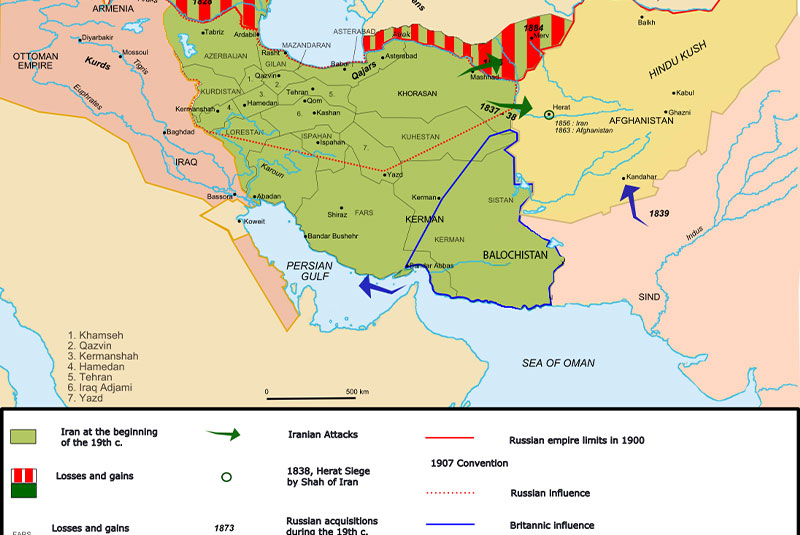
The Qajar clan was one of the Turkmen. The assassination of Nader Shah Afshar in 1747 AD brought chaos to Iran, the result of which was the spread of civil wars among the claimants to the throne, ultimately leading to Karim Khan Zand's victory. After this victory, Karim Khan kept several Qajar chiefs as hostages, including Agha Mohammad Khan, the young son of the head of the tribe. After Karim Khan's death, Agha Mohammad Khan took advantage of the confusion. He quickly moved to Mazandaran, the place where his clan was based, and started his first efforts - uniting the various Qajar clans - to seize the throne. Finally, after nearly 20 years of continuous campaigning, he was crowned in a small village called Tehran in 1795, and the Qajar dynasty was thus born.
During the time of Naser al-Din Shah, due to the mutual competition of the big countries and the shrewdness of Naser al-Din Shah, Iran was more successful in maintaining its territorial unity than the vast and scattered Ottoman state because it had a geographically more coherent region. Despite this, the war expenses and extravagance of the Qajar sultans put the nation under the burden of foreign government debts. They left them under the pressures of failure and harmful social, economic, and cultural effects.
During the reign of Mozaffar ad-Din Shah, a movement arose among the people to obtain political freedom and constitutional government. Mozaffar ad-Din Shah had to respond positively to these demands in 1906. After that, the power and prestige of the Qajar sultans decreased noticeably. During World War I, Iran remained officially neutral, but the Ottoman, Russian and British forces fought within it despite the neutrality. Local separatist and revolutionary movements emerged around the country at the war's end. Hence, it was not so difficult for an army general like Reza Khan - the first king of the Pahlavi dynasty - to persuade the National Assembly to dethrone the Qajar dynasty (1925 AD) and thus destroy the 150-year-old scroll of the Qajar dynasty.
Antiquities of the Qajar Dynasty:
Golestan Palace (Tehran), Imam or Shah Mosque, Jame Mosque, Takyeh Dowlat, Suleymanieh Palace (Karaj), Nabi Mosque (Qazvin), Imam Mosque of Semnan (Semnan), Hajj Agha Ali Mosque (Kerman), Motahari Mosque or Masjed-e Sepahsalar (Tehran), Shahrestanak Palace (Tehran) and many historical houses around Iran
Most of the contents of this article are extracted from (Nouri Shadmani, 2011[19]).

